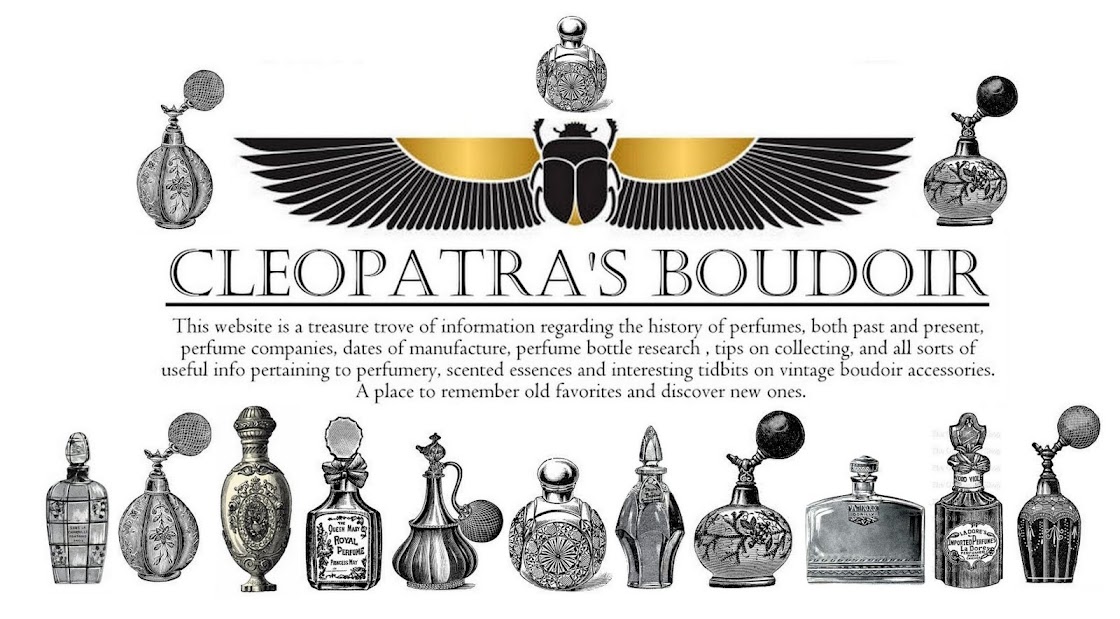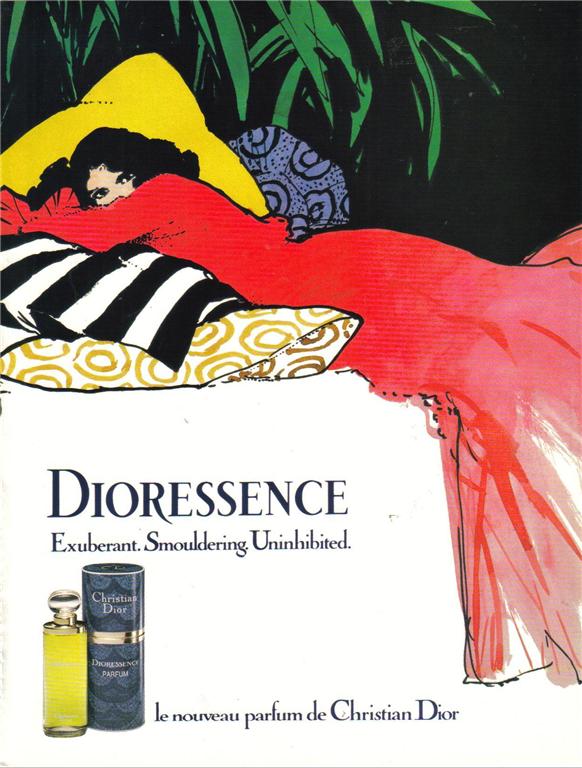Pages
- HOME
- CONTACT ME
- ABOUT ME
- WHAT'S IT WORTH?
- SELLING VINTAGE PERFUME TIPS
- BUYING VINTAGE PERFUMES
- HOW OLD IS IT?
- IS IT DISCONTINUED?
- FRAGRANCE CLASSIFICATION
- HOW CAN YOU HELP?
- TYPES OF PERFUMED PRODUCTS
- BOOKS WANTED
- FURTHER READING
- FACTICES & DUMMY BOTTLES
- WHERE TO BUY
- FRAGRANCE STORAGE TIPS
- FRAGRANCE PROFILES A to G
- FRAGRANCE PROFILES H to L
- FRAGRANCE PROFILES M to R
- FRAGRANCE PROFILES S to Z
- GDPR MESSAGE
- MAKE YOUR OWN PERFUME
- SCENT STORIES
Welcome!
Thursday, April 20, 2017
Gloria Swanson and Perfume
Sunday, April 16, 2017
Shalimar by Guerlain c1925
Saturday, April 15, 2017
Mistigri by Jacques Griffe c1953
Thursday, April 13, 2017
Monday, April 10, 2017
Saturday, April 8, 2017
Black Casket by Novaya Zarya c1947
The perfume was created by Vitkovskaya A.P.
Black Casket was imported into the United States by an American company known as The Russian Shop, who imported various Russian fragrances in the 1960s.
The name was said to be changed to "Treasure Chest" by 1961.
Anglo-American News - Volume 28, 1961:
"Russian marketing experts show an acute sense of the problems of product presentation and merchandising in foreign markets. For instance, a big-selling perfume on the Soviet domestic-market, Black Casket, has been renamed Treasure Chest."
Wednesday, April 5, 2017
PERFUME HACK - Removing the Odor of Perfume
Ever have stubborn perfume odor that lingers on your hands even after washing them over and over again? If you want to get it removed, you can use this quick hack:
- Take one part of household ammonia and mix it with three parts water. Rinse your hands in this mixture a few times and then wash your hands with soap and water. It should take the perfume smell away. Remember, you must use the diluted ammonia to keep the skin from getting irritated.
- Another quick method is to make a paste of baking soda and water, apply it onto the skin where the perfume odor remains and rub gently. Then rinse off.
How to Remove Perfume Odor from Clothing or Linens:
Sprayed your favorite perfume on your nice dress? How about your scarf, does it seem to retain the odor of last year's perfume? Did you purchase a second hand garment and want to get that stinky perfume smell out of it? A good alkali will kill the odor of almost any perfume and again, household ammonia will help you out! It also will help boost the performance of your detergent and brighten your whites.
- You can add 1/2 cup of household ammonia to the water, along with the detergent, before you add clothes into the washing machine. If you are hand washing, you can try the method of one part ammonia to three parts water and a little bit of detergent so that it will not irritate your skin while you wash. Rinse and repeat if necessary.
- Another method is to soak clothing in a sink or washing machine filled with warm water and one cup baking soda before washing.
- Some peroxide will also help take the perfume stains out of your linens. You may wish to do a separate rinse with this ingredient.
- Fill a spray bottle with cheap, high proof vodka. Then spray on the perfumed area of your clothing. The vodka dries odorless and should kill any scent. This is an effective method if you cannot wash the garment such as silk.
How to Remove Perfume Odor from Empty Bottles:
- Wash it with hot soap and water using a bottle brush. Rinse with clear water. Then fill the bottle with a strong solution of borax and warm water and let stand for several hours. Then empty the bottle and rinse again. An alkali will kill the odor of almost any perfume.
- If this method does not work, or you do not have borax on hand, you can use household ammonia. But do not dilute it, pour it straight from the bottle into the perfume bottle, insert the stopper and allow it to stand for a few hours. Then you can empty it and rinse with warm soapy water.
- To remove odor from bath salts bottles and jars so that they could be use for fruits or other foods, fill the bottle or jar with a very strong solution of hot water and apple cider vinegar (about 1/4 cup vinegar). Let stand a couple of hours; rinse with hot water, then add another mixture of vinegar and water if necessary, and you will find odor will have completely disappeared. Just washing with soap and water will not take away the smell.
How to Remove Perfume Spillage Odor from Carpet or Upholstery:
Did you accidentally knock over a bottle of perfume onto the rug or sofa and now the smell is overpowering?
- Mix one quart of 3 percent hydrogen peroxide, 1/4 cup of baking soda and a teaspoon of liquid dishwashing detergent in a spray bottle to get rid of perfume odor in carpet or on upholstery. Spray the affected area and let sit for 24 hours. Blot away the excess with a paper towel and let air dry.
Tuesday, April 4, 2017
Eau de Fleurs by Nina Ricci c1980
Eau de Fleurs by Nina Ricci: launched in 1980. Created by Betty Busse as an eau de toilette. A more intense version of the fragrance named Fleurs de Fleurs, in eau de parfum concentration was also released in 1982.
Wednesday, March 29, 2017
Thursday, March 23, 2017
Elgin American Beauty Compacts, Cigarette Cases & Lighters c1951 Advertisement
Monday, March 20, 2017
Master Merchandise Corp
Master Merchandise Corp., based in New York, was a fragrance distribution brand that operated during the 1950s. Their business model revolved around creating knockoffs of popular fragrances, cleverly naming their products after well-known plays, songs, or movies of the era. This approach not only captured the zeitgeist of the time but also allowed them to capitalize on the widespread recognition of these cultural references. Despite this strategic marketing, Master Merchandise Corp. was a short-lived enterprise, quickly fading from the competitive fragrance market.
The company was associated with several brand names, each with its own unique history and connection to the fragrance industry. Codell, Inc. and Miss Codell were two such brands, likely developed to appeal to different segments of the market. The former may have been positioned as a general brand, while the latter perhaps targeted a more feminine audience, reflecting the gendered marketing strategies common in that era.
Another affiliated brand was Vivian Parfums Inc., which originally started as a brand under Vivaudou, a company known for its perfumes and cosmetics in the early 20th century. The acquisition or rebranding of Vivian Parfums by Master Merchandise Corp. indicates a strategic attempt to leverage an established name in the industry, although it’s unclear how successful this endeavor was.
Lastly, Peggy Page was another brand linked to Master Merchandise Corp. This brand originally belonged to Klinker Manufacturing Co., having been established in 1926. The revival or repurposing of Peggy Page under Master Merchandise Corp. suggests a desire to bring back a recognizable name from a previous era, possibly to evoke a sense of nostalgia or reliability among consumers.
While Master Merchandise Corp.’s time in the fragrance industry was brief, their approach to branding and marketing reflects the mid-20th century's broader trends of capitalizing on popular culture and the evolving landscape of fragrance distribution.
Murasaki by Shiseido c1980
The name translates to "purple" which is reflected in the bottle design which features purple accents. The name also refers to Lady Shikibu Murasaki, the Chinese royal court figure of the 11th century who penned the love story "Tale of Ghenj".
Tuesday, March 7, 2017
Tuesday, February 28, 2017
Farouche by Nina Ricci c1973
Wednesday, February 22, 2017
Friday, February 3, 2017
Fairy Tale of Tsar Saltan by Novaya Zarya c1949
Новая Заря: СКАЗКА О ЦАРЕ САЛТАНЕ
Thursday, January 12, 2017
Tuesday, January 10, 2017
Monday, December 26, 2016
MW de Messire c1972
The MW stands for "Modern Woman", however, a blurb in a newspaper article mentioned that "MW" stands for "whatever you want it to be" and that the fragrance was unisex. "The first modern and vigorous fragrance created for women in a line for men."
Sunday, December 11, 2016
Divine by D'Orsay c1947
Monday, December 5, 2016
Tendre Poison by Christian Dior c1994
Wednesday, November 30, 2016
Tuesday, November 22, 2016
Sunday, November 20, 2016
Saturday, November 19, 2016
Friday, November 18, 2016
Friday, November 11, 2016
Gigolo by Germaine Monteil c1951
Tuesday, November 1, 2016
Thursday, October 27, 2016
Si by Schiaparelli c1957
Monday, October 24, 2016
Tuscany Per Donna by Estee Lauder c1992
Thursday, October 20, 2016
Dans la Nuit by Worth c1924
Sunday, October 16, 2016
Collecting Pink Glass Commercial Perfume Bottles
Wednesday, October 12, 2016
Tuesday, October 11, 2016
Midnight Poison by Christian Dior c2007
Friday, September 30, 2016
Thursday, September 22, 2016
L'Origan by Coty c1905
Sunday, September 18, 2016
Dioressence by Christian Dior c1979
From 1979 onward, the fragrance was available in parfum, eau de toilette, body lotion, dusting powder, hand soap, talc, body cream, bath gel, solid perfume,
In 1982, the Dioressence Esprit de Parfum was introduced.
Thursday, September 8, 2016
Kali by Dana c1943
Thursday, September 1, 2016
Marathon Compacts & Vanities c1927 Advertisement
Featured Post
Faking Perfume Bottles to Increase Their Value
The issue of adding "after market" accents to rather plain perfume bottles to increase their value is not new to the world o...






















































